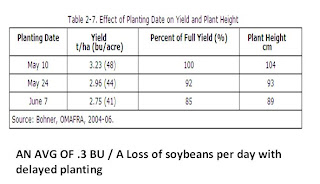There has been a focus, and rightly so, the past two years on planting beans early. Both Pioneer and OMAFRA agree that yield potential is lower with later planting dates, however, there is still time to produce a respectable soybean crop as long as we don't panic and muck it in.
We are now into the 4th week of May which is traditionally the time when the majority of soybeans are planted in Ontario.
Let's review some factors to consider before we get back into the field.
1. Variety selection
Stay the course. Soybeans are opposite to corn. There is no need to switch maturities as planting dates get later. Full season beans will still deliver more yield potential. Many of us like to have the option of planting wheat, which make late group 0 to early group 1, 27-2800 HU, varieties the best choice to balance yield with earlier harvest dates.
2. Agronomics
Horst Bohner's chart is worth looking at again.
Variety height becomes a factor. Stay away from short varieties. As planting dates get later, all varieties will grow shorter. Again, corn is the opposite, growing taller as May turns to June. The reason beans become dwarfs is after June 21 the shorter daylength prompts them to start flowering. When we plant on June 1 there is only 21 days for beans to grow vegetatively before the reproductive hormones start to accumulate. Beans actually have to get to the 2nd trifoliate before they reach puberty, so to speak. This makes a very small bean plant initiating pods close to the ground which means more header loss in October.
In addition to harvest losses, a smaller plant cannot support the same yield potential. A one month delay in planting date results in a 9 day delay in harvest date. This time squeeze affects both the vegetative and the pod fill durations. The photosynthetic factory is simply not big enough to support a lot of flowers and pods at the same time, which explains why .3 bu loss per day is real.
3. Row width and seeding rate
This chart identifies the number of bags per acre required to hit the recommendeed seeding rates for each row width. Going to narrow rows is a good plan as planting dates move into June. Increase seeding rates as well. Crowding bean plants within the row will force individual plants to grow taller as they try to compete with their neighbours.





No comments:
Post a Comment